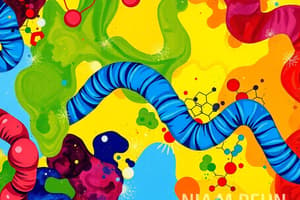Podcast
Questions and Answers
What is formed when two amino acids undergo a condensation reaction?
What is formed when two amino acids undergo a condensation reaction?
- Polypeptide
- Dipeptide (correct)
- Tripeptide
- Protein
How many amino acids are required to form a tripeptide?
How many amino acids are required to form a tripeptide?
- Three (correct)
- Two
- Four
- One
Which describes the primary structure of a protein?
Which describes the primary structure of a protein?
- The overall shape due to interactions between different polypeptide chains
- The specific three-dimensional arrangement of amino acids
- The sequence of amino acids in a polypeptide chain (correct)
- The folding of the polypeptide into alpha helices and beta sheets
Which of the following structures contributes to the tertiary and quaternary structure of proteins?
Which of the following structures contributes to the tertiary and quaternary structure of proteins?
What role do amino acids play in the enzyme active site?
What role do amino acids play in the enzyme active site?
What is the disadvantage of myoglobin regarding structural complexity compared to hemoglobin?
What is the disadvantage of myoglobin regarding structural complexity compared to hemoglobin?
Which type of bonding contributes to the tertiary structure of proteins?
Which type of bonding contributes to the tertiary structure of proteins?
Which feature differentiates hemoglobin from myoglobin?
Which feature differentiates hemoglobin from myoglobin?
How do enzymes achieve their specific binding properties to substrates?
How do enzymes achieve their specific binding properties to substrates?
What process leads to the alteration of a protein's normal function due to structural changes?
What process leads to the alteration of a protein's normal function due to structural changes?
Which of the following sequences represents a tripeptide?
Which of the following sequences represents a tripeptide?
In protein primary structure, what determines the unique sequence of amino acids?
In protein primary structure, what determines the unique sequence of amino acids?
What structural feature is characterized by local folding patterns stabilized by hydrogen bonds?
What structural feature is characterized by local folding patterns stabilized by hydrogen bonds?
What is the maximum number of unique dipeptides that can be formed from glycinea and alanine?
What is the maximum number of unique dipeptides that can be formed from glycinea and alanine?
How many distinct tripeptides can be formed from glycine, alanine, and phenylalanine if all three must be used?
How many distinct tripeptides can be formed from glycine, alanine, and phenylalanine if all three must be used?
In the context of protein structure, what does the primary structure specifically refer to?
In the context of protein structure, what does the primary structure specifically refer to?
Which description pertains to tertiary structure in proteins?
Which description pertains to tertiary structure in proteins?
What defines the quaternary structure of a protein?
What defines the quaternary structure of a protein?
Which type of amino acids must be consumed in the diet as they cannot be synthesized by the body?
Which type of amino acids must be consumed in the diet as they cannot be synthesized by the body?
In the formation of dipeptides, what is the process called by which two amino acids are combined?
In the formation of dipeptides, what is the process called by which two amino acids are combined?
What causes an amino acid to become conditionally essential?
What causes an amino acid to become conditionally essential?
Flashcards
Primary Structure of Protein
Primary Structure of Protein
The linear sequence of amino acids in a polypeptide chain.
Secondary Structure of Protein
Secondary Structure of Protein
Regions of repeated folding patterns in the polypeptide chain like alpha-helices and beta-sheets, stabilized by hydrogen bonds.
Tertiary Structure of Protein
Tertiary Structure of Protein
The overall 3D shape of a polypeptide chain, resulting from interactions between amino acid side chains (R groups).
Quaternary Structure of Protein
Quaternary Structure of Protein
Signup and view all the flashcards
Enzyme Structure
Enzyme Structure
Signup and view all the flashcards
Denaturation
Denaturation
Signup and view all the flashcards
Hemoglobin
Hemoglobin
Signup and view all the flashcards
Myoglobin
Myoglobin
Signup and view all the flashcards
Amino Acid Structure
Amino Acid Structure
Signup and view all the flashcards
Protein Building Blocks
Protein Building Blocks
Signup and view all the flashcards
Amino Acid Types
Amino Acid Types
Signup and view all the flashcards
Protein Formation
Protein Formation
Signup and view all the flashcards
Protein Size
Protein Size
Signup and view all the flashcards
Peptide bond formation
Peptide bond formation
Signup and view all the flashcards
Isoelectric pH
Isoelectric pH
Signup and view all the flashcards
Essential amino acids
Essential amino acids
Signup and view all the flashcards
Nonessential Amino Acids
Nonessential Amino Acids
Signup and view all the flashcards
Dipeptide
Dipeptide
Signup and view all the flashcards
Primary protein structure
Primary protein structure
Signup and view all the flashcards
Protein levels of structure
Protein levels of structure
Signup and view all the flashcards
Number of possible dipeptides from 2 amino acids
Number of possible dipeptides from 2 amino acids
Signup and view all the flashcards
Study Notes
Amino Acids/Proteins
- Proteins/polypeptides are chains formed by the condensation/combination of 20 different α-amino acids.
- Polypeptides can be di-, tri-, etc., up to 10 amino acids (aa).
- Proteins are longer than 10 aa units; molecular weight (MW) >10,000.
- An amino acid contains a carboxyl group (-COOH) and an amino group (-NH₂).
- All amino acids in proteins have the -NH₂ group attached to the α carbon of the -COOH group (as well as the H and R).
- Naturally occurring α-amino acids, except glycine (R=H), are chiral and the L-stereoisomer.
- There are 20 α-amino acids in naturally occurring proteins.
- By convention, the -NH₂ group is placed to the left.
- Each amino acid has a common name often ending in "-ine."
- There are approximately 150 other physiologically important amino acids, such as GABA.
Classification of Amino Acids
- Amino acids can be categorized as nonpolar (hydrophobic) or polar (hydrophilic).
Nonpolar R Groups (Hydrophobic)
- Examples include glycine, alanine, proline, valine, tryptophan, isoleucine, methionine, leucine, and phenylalanine.
Polar R Groups (Hydrophilic)
- Examples include serine, asparagine, threonine, cysteine, glutamic acid, glutamine, tyrosine, histidine, lysine, arginine.
Amino Acids - General Properties
- Amino acids contain both an acidic functional group (-COOH) and a basic one (-NH₂), NH or N.
- Reactions involving amino acids are highly pH-dependent.
Peptide Bonds
- Peptide bonds form by condensation reactions, where the acid group (COOH) and amine group (-NH₂) of two different amino acids combine and release a water molecule.
- When peptide bonds are broken, this is called hydrolysis. The hydroxyl group (OH) and hydrogen (H) of a water molecule are added to the peptide bond.
pH-Dependent Properties
- Zwitterionic structures contain both N-H⁺ and COO⁻.
- At low pH, the COO⁻ group is protonated.
- At high pH, the N-H⁺ group loses a hydrogen.
- Isoelectric pH differs for each amino acid due to structural differences.
Essential, Nonessential, and Conditional Amino Acids
- Essential amino acids must be consumed in the diet.
- Nonessential amino acids can be synthesized in the body.
- Some amino acids are conditionally essential. They cannot be synthesized due to illness, lack of necessary precursors.
Dipeptides
- Dipeptides are composed of two amino acids.
- Examples include GG, AA, GA, and AG.
Tripeptides
- Tripeptides are composed of three amino acids.
- Examples include AAA, PPP, GGG, and variations.
Levels of Protein Structure
- Primary structure: The sequence of amino acids in the protein chain and the location of disulfide bridges.
- Secondary structure: The conformation or shape of the protein backbone.
- Tertiary structure: The 3D structure of the entire polypeptide.
- Quaternary structure: Occurs in proteins with more than one polypeptide chain describing the arrangement of the chains.
Specific Protein Examples
- Insulin: A protein hormone with a specific amino acid sequence that regulates blood sugar levels.
- Hemoglobin: A protein that transports oxygen in the blood, made up of multiple polypeptide chains.
Myoglobin structure
Myoglobin is a protein that stores oxygen in muscles. It has a single polypeptide chain.
Protein Classification by Structure
- Simple proteins consist of only amino acids.
- Fibrous proteins are insoluble and mostly structural (e.g., hair, horn).
- Globular proteins are soluble and often reactive (e.g., enzymes).
- Conjugated proteins have non-amino acid components (e.g., Lipoproteins, glycoproteins, metalloproteins).
Common Protein Functions
- Enzymes: Biological catalysts
- Contractile: Muscle movement
- Hormones: Signaling molecules (insulin, growth hormone)
- Neurotransmitters: Nerve signals
- Storage: Nutrient storage.
- Transport: Transporting substances (hemoglobin, transferrin)
- Protective: Antibodies
- Toxins: Poisonous substances (snake venom)
Vegetarian Diets
- The main challenge for vegetarians is obtaining enough high-quality proteins with the correct balance of essential amino acids.
Protein Content
- Different foods have varying protein content.
Malnutrition
- Malnutrition occurs when insufficient complete protein, especially essential amino acids, leads to poor bodily function.
- Symptoms include extreme emaciation, bloated abdomen, and ultimately death.
Glycolipids
- Glycolipids are derivatives of ceramides with carbohydrate directly attached to the ceramide.
- They lack a phosphocholine group that is present in sphingomyelin.
Glycoproteins
- Glycoproteins are proteins that have oligosaccharide chains (glycans) covalently attached to their peptide side-chains.
- The attaching process is called glycosylation and happens during co-translational modification and post-translational modification.
Roles of Glycolipids and Glycoproteins
- Glycolipids and glycoproteins serve many functions in the body, such as being cell surface markers, receptors for viruses and toxins, participating in cell interactions, blood group antigens, and undergoing changes during cell transformation, and more.
Denaturation
- Denaturation is any physical or chemical process that changes a protein's structure and makes it unable to perform its normal function.
- Denaturation can be reversible or irreversible depending on the protein and the extent of the change.
Studying That Suits You
Use AI to generate personalized quizzes and flashcards to suit your learning preferences.




